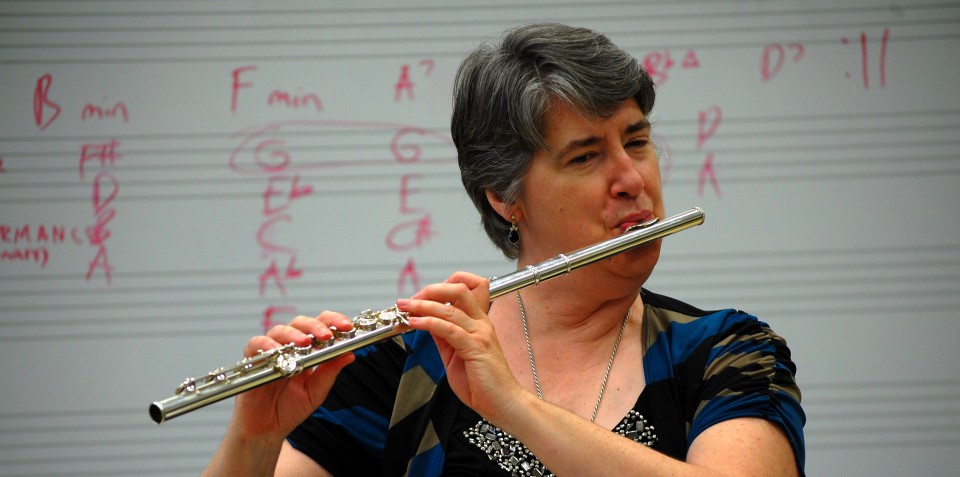The short answer to that question is, “It depends”. What does it depend on? It depends on a student’s ability to blow with a steady air stream and to differentiate between air speed and air quantity. Learning to differentiate between air speed and quantity takes time for the student and an understanding of sound pedagogy from the teachers who work with the student.
 When a kid starts on the flute, the first job is to learn to direct the air properly to hit the strike edge of the blow hole. Then they need to learn to change the blowing angle to play in the different registers. Often at this stage the student is blowing through a large aperture, expending a lot of air, huffing and puffing, making a fuzzy sound and having trouble sustaining anything longer than two or three beats. As they continue practicing, most of the time the student learns to blow through a smaller aperture, control their breath and make a clearer tone.
When a kid starts on the flute, the first job is to learn to direct the air properly to hit the strike edge of the blow hole. Then they need to learn to change the blowing angle to play in the different registers. Often at this stage the student is blowing through a large aperture, expending a lot of air, huffing and puffing, making a fuzzy sound and having trouble sustaining anything longer than two or three beats. As they continue practicing, most of the time the student learns to blow through a smaller aperture, control their breath and make a clearer tone.
Is this a good time to start introducing dynamics? I would say no, absolutely not and here is why. You can do more harm than good for your kids because they start trying to do what you are asking without having the skill set to play with dynamics correctly. Kids will pinch the aperture, which can make them play sharp. They start rolling the flute in and covering more. This will make the pitch flat. They try to control the air by squeezing their throats. Do you really want your students to sound like they are strangling? And they don’t really know anything about managing the air stream so they wind up trying to control the dynamics with their lips, tongue, throat, size of the oral cavity, etc. Kids are enormously creative in their solutions but the results for both pitch and tone can be devastating. And they wind up building in habits that they may never overcome.
A few pointers for teaching dynamics:
- Never mind about dynamics for a least the first year to two years of playing.
- Teach them to blow with a steady, supported air stream always (using their abdominal muscles to drive the air).
- Teach them that the size of the aperture stays pretty much the same throughout the range of the flute.
- Show them that the air speed and air quantity are not the same thing. You can play very softly provided that the air column is moving quickly enough with enough pressure.
- Dynamics on flute are controlled by a steady air speed and varying the quantity of air, not with the embouchure. The embouchure’s job is merely to point the air in the correct direction. Think of a garden hose. The actual source of the water pressure is far from the nozzle. The nozzle directs the water wherever it is pointed.
Your students will develop a wide palette of dynamic expression if you spend time helping them learn to control the air column in the first couple years of playing. It all comes down to how you manage the air.
If you find these entries helpful, subscribe, share with your colleagues and come back regularly for more flute tips. Please comment and feel free to ask questions. What do you want to know about flute pedagogy? Maybe the answer to your question will be the next flute tip. Find me on Facebook or email me your questions at dr_cate@sbcglobal.net. For information about clinics and workshops click here.

Please explain the physics of changing either the mass flow rate or the volumetric flow rate without changing the orifice or the velocity. I think you’ve got it wrong.
LikeLike
Thank you, Jed, for your comment. I am not changing the size of the aperture. However I am changing the direction with which I am aiming the air. The other thing that does change somewhat is the firmness with which I grip the air. One needs more firmness in the contour of the aperture to play in the low register and a more relaxed grip on the air stream to play in the third octave. Doing it this way will work only if the abdominal muscles are generating a supported air column. Similarly, when playing loudly, one has to aim the air stream lower to avoid going sharp. Conversely, when playing softly, one has to aim the air higher to avoid going flat. I can tell you it is possible to play a “hard” note like the high E very softly with just a tiny thread of air provided the air column is moving fast enough.
I am not a physicist so my comments and suggestions are based on experiential observation. The last time I had any physics was when I was in high school. It is not my area of expertise. Can you explain mass flow rate in terms I can understand? My understanding of volumetric flow rate is this refers to the quantity of air.
LikeLike
Pingback: Favorite blog posts, September 2015 | Bret Pimentel, woodwinds